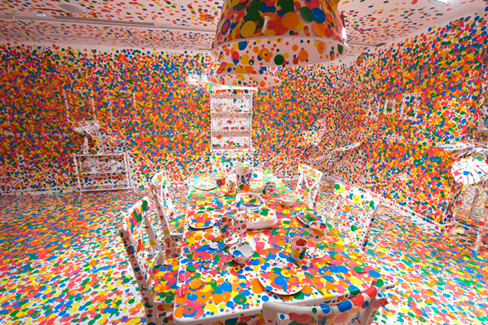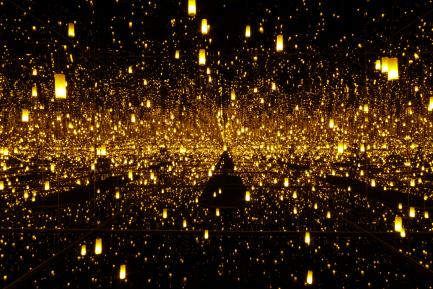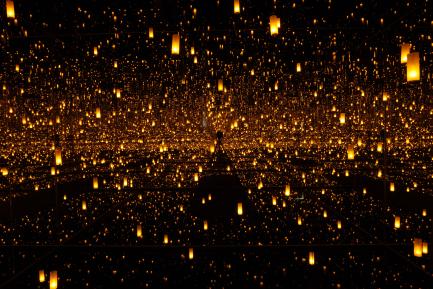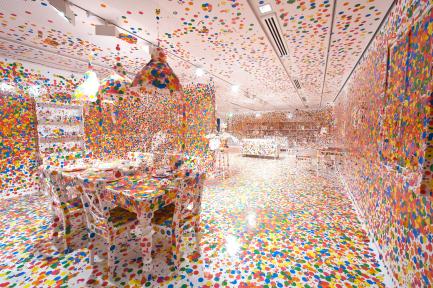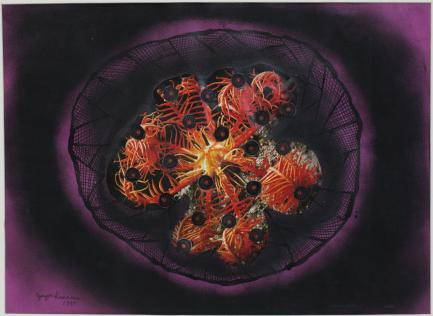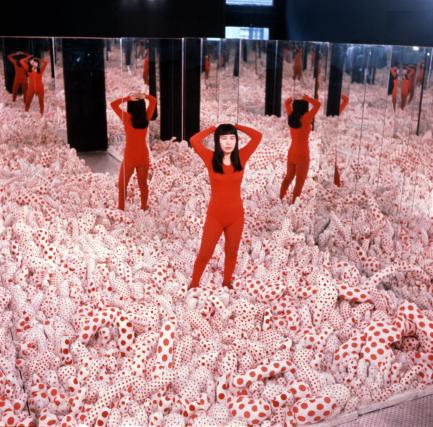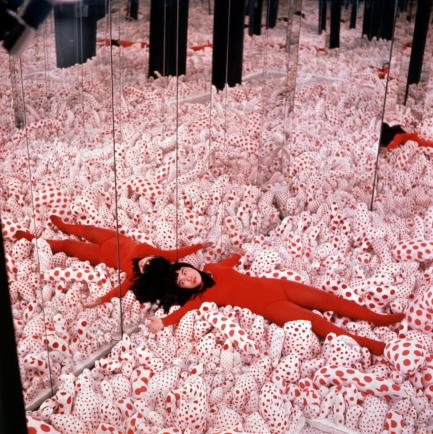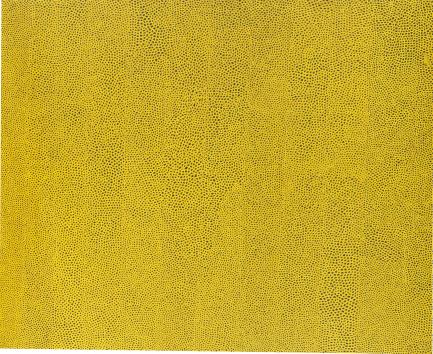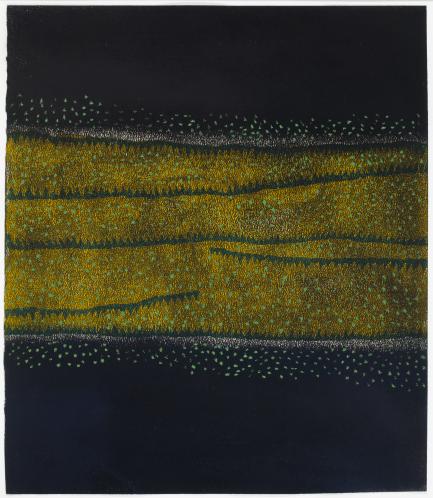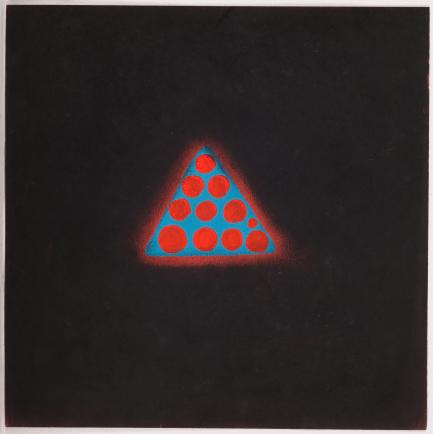Hirshhorn’s “Yayoi Kusama: Infinity Mirrors” Is the First Exhibition to Span Five Decades of the Artist’s Immersive Installations
“Yayoi Kusama: Infinity Mirrors” at the Smithsonian’s Hirshhorn Museum and Sculpture Garden is the first institutional exhibition to explore the evolution of the celebrated Japanese artist’s immersive, multireflective installations over more than five decades. On view from Feb. 23, 2017, to May 14, 2017, this ambitious survey exhibition addresses the phenomenological impact of Yayoi Kusama’s Infinity Mirror Rooms in relation to her career as a whole, and it presents six of her most iconic kaleidoscopic environments alongside two large-scale installations and key paintings, sculptures and works on paper from the early 1950s to the present.
A North American tour, the first in nearly two decades, is anticipated. The Seattle Art Museum is currently planning to host the exhibition in the summer of 2017, with additional venues to be announced.
“Yayoi Kusama is among the most influential artists alive today,” said Melissa Chiu, the Hirshhorn’s director. “A worldwide phenomenon, she has created a vast oeuvre that defies traditional classification, and we are honored to present the first survey of her Infinity Mirror Rooms.”
Organized chronologically, “Yayoi Kusama: Infinity Mirrors” (working title) begins with the artist’s milestone installation “Infinity Mirror Room—Phalli’s Field” (1965/2016), in which she displayed a dense field of hundreds of red-spotted phallic tubers in a room lined with mirrors.
The exhibition will also include the “Love Forever” (1966/1995) mirror room, a hexagonal chamber the artist used to stage performances inside her studio, in which viewers will peer in from outside to see flashing lights that endlessly reflect from the ceiling onto the floor.
Kusama’s signature bold polka dots will be featured in “Dots Obsession—Love Transformed into Dots” (2009), a multimedia installation with a domed mirror room surrounded by multiple inflatables suspended from the ceiling, as well as more recent spectacular LED environments filled with lanterns or crystalline balls, such as “Aftermath of Obliteration of Eternity” (2009) and “Souls of Millions of Light Years Away” (2013), that hover into realms of virtual space.
“The museum’s circular form can be read as an infinite space in itself and provides an ideal setting for these constructed environments,” said Hirshhorn Associate Curator Mika Yoshitake, who organized the exhibition. “As visitors explore the building, they will inevitably become part of the works, activating Kusama’s sensory pilgrimage. The infinity rooms invite the viewer to experience a myriad of dualities, challenging preconceived notions of autonomy, time and space.”
A selection of more than 60 paintings, sculptures and works on paper will also be on view, showcasing many of Kusama’s lesser-known collages, made after her return to Japan in 1973. The exhibition traces the artist’s trajectory from her early surrealist works on paper, Infinity Net paintings and Accumulation assemblages to recent paintings and soft sculptures, highlighting recurring themes of nature and fantasy, utopia and dystopia, unity and isolation, obsession and detachment, and life and death.
The presentation will conclude with Kusama’s iconic participatory installation “The Obliteration Room” (2002), an all-white replica of a traditional domestic setting. Upon entering, visitors will be invited to cover every surface of the furnished gallery with multicolored polka dot stickers, gradually engulfing the entire space in pulsating color.
“Yayoi Kusama: Infinity Mirrors” will be accompanied by an exhibition catalog that takes an unprecedented interdisciplinary approach to her work and includes an illustrated chronology based on new archival material. The contributing authors will introduce new research that sheds light on this pioneering contemporary artist, including an introduction by Yoshitake, essays by Gloria Sutton and Alexander Dumbadze and an interview with Kusama conducted by Chiu.
About the Artist
Kusama was born in Matsumoto, Nagano, in 1929. Today, she continues to produce paintings at her studio in Tokyo. She studied traditional Nihonga (Japanese-style) painting in Kyoto and moved to New York City in 1958. There, she was active in avant-garde circles during the formative years of pop art and minimalism, exhibiting her work alongside such artists as Andy Warhol, Claes Oldenburg and Allan Kaprow—figures who have cited Kusama as influential to the development of assemblage, environmental art and performative practices.
Kusama exhibited widely in Italy, Germany and the Netherlands in the mid-’60s, participating in exhibitions with artists associated with Nul, Zero and the New Tendency in Europe, where she began developing her interest in the optics and interactive elements of mirrors, electric lights, sound and kinetics.
Kusama’s fame grew in the late ’60s through her radical antiwar happenings, which espoused nudity and polka dots in the streets of New York. Because of ongoing struggles with her mental health, Kusama returned to Japan in 1973, where she has since resided. In recent years, Kusama has achieved celebrity status and tremendous critical respect.
For more information on “Yayoi Kusama: Infinity Mirrors,” visit hirshhorn.si.edu/collection/yayoi-kusama/.
Thumbnail photo: “The Obliteration Room” (2002). Collaboration between Kusama and Queensland Art Gallery, commissioned by Queensland Art Gallery. Artwork © Yayoi Kusama.
# # #
SI-191-2016

